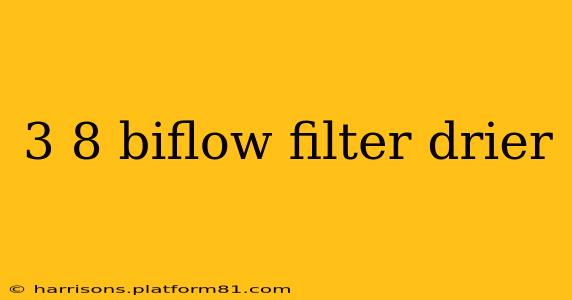Understanding 3-8 Biflow Filter Dryers: A Comprehensive Guide
The term "3-8 biflow filter dryer" might seem cryptic at first glance, but it refers to a specific type of industrial drying and filtration equipment. This guide will delve into the specifics, explaining what it is, how it works, its applications, and common questions surrounding this technology. This detailed analysis aims to provide a comprehensive understanding for both experts and those new to the field of industrial drying.
What is a 3-8 Biflow Filter Dryer?
A 3-8 biflow filter dryer is a specialized piece of equipment designed for efficient and effective drying and filtration of various materials. The "3-8" likely refers to a specific model designation or size range from a particular manufacturer, indicating the filter's capacity or dimensions. "Biflow" signifies that the process utilizes two flows: one for the drying medium (typically hot air) and another for the material being processed. This counter-current or co-current flow design optimizes heat transfer and drying efficiency, often resulting in shorter processing times and reduced energy consumption compared to single-flow systems. The filter element is crucial, removing solids from the liquid or gas phase during the process. The exact filter media will vary depending on the material being processed, demanding careful consideration for compatibility and effectiveness.
How Does a 3-8 Biflow Filter Dryer Work?
The process typically involves introducing the wet material into the dryer vessel. Hot air (or another suitable drying medium) is then circulated through the vessel, either co-currently (in the same direction) or counter-currently (in the opposite direction) to the material flow. This heats the material, causing moisture to evaporate. Simultaneously, the filter element separates the dried solids from the evaporated moisture and any other byproducts. The dried material is then discharged, while the moisture-laden air is often vented or recycled (depending on the specific system and environmental considerations). Precise control over parameters like temperature, airflow, and pressure is crucial for optimizing the drying process and achieving the desired product quality.
What are the Applications of a 3-8 Biflow Filter Dryer?
The versatility of biflow filter dryers makes them suitable for a wide range of industrial applications. These include:
- Pharmaceutical industry: Drying and purifying sensitive pharmaceutical ingredients.
- Chemical processing: Drying and filtering various chemicals and intermediates.
- Food processing: Drying food products while preserving their quality.
- Environmental remediation: Removing contaminants from wastewater or other liquids.
The specific application will dictate the materials used in construction, the filter media employed, and the overall operating parameters.
What are the Advantages of Using a 3-8 Biflow Filter Dryer?
Several advantages contribute to the popularity of these dryers:
- High efficiency: The biflow design optimizes heat and mass transfer, leading to faster drying times and reduced energy costs.
- Improved product quality: Gentle drying conditions minimize the risk of product degradation.
- Continuous operation: Many models allow for continuous processing, maximizing productivity.
- Reduced waste: Efficient filtration minimizes material loss and reduces waste disposal costs.
What are the Maintenance Requirements for a 3-8 Biflow Filter Dryer?
Regular maintenance is essential to ensure optimal performance and longevity. This typically includes:
- Regular filter cleaning or replacement: The frequency depends on the type of material being processed and the filter's capacity.
- Inspection of seals and gaskets: Preventing leaks is crucial for efficient operation and safety.
- Periodic inspection of heating elements and motors: Early detection of potential issues can prevent costly repairs.
What are the Different Types of 3-8 Biflow Filter Dryers?
The exact variations within the "3-8" designation will depend heavily on the manufacturer. However, general variations might include differences in:
- Size and capacity: The volume of material that can be processed.
- Heating methods: Direct or indirect heating systems.
- Filter media types: Different filter media are suitable for different materials and applications.
- Automation levels: Some models offer advanced automation features for greater control and monitoring.
This information provides a strong foundation for understanding 3-8 biflow filter dryers. Remember to consult the specific manufacturer's documentation for detailed specifications and operational procedures relevant to a particular model. The information presented here is for general knowledge and should not be used as a substitute for professional advice.
